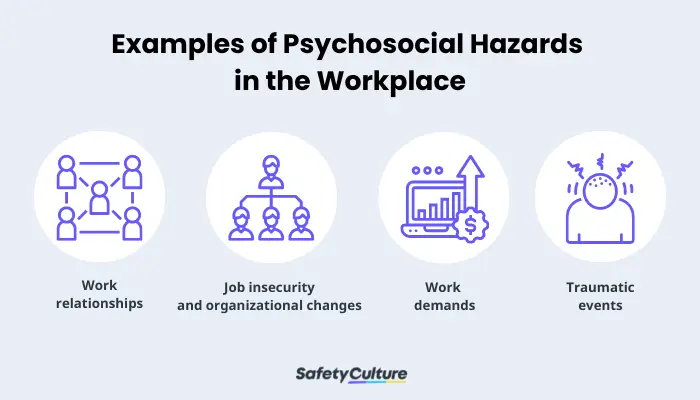What are Psychosocial Hazards?
Psychosocial hazards are any hazards or risks in one’s environment and society that can cause harm. In a workplace setting, psychosocial hazards are things that can cause stress, which can then affect a person physically, psychologically, or both.
Difference Between Psychosocial and Psychological Hazards
In terms of workplace hazards, psychological safety and psychosocial safety are separate concerns. However, managing psychological safety can help greatly with managing psychological safety and hazards as well.
By definition, anything “psychosocial” refers to the relationships between humans with their thoughts, behaviors, and social environment. It is a term that refers to how mental health, or psychological factors, work with social factors and how they can affect a person. On the other hand, the term “psychological” refers to things, feelings, and experiences that relate to the human mind and mental health.
Following this, it can be said then that psychological factors are an aspect of one’s psychosocial state, and managing it can be very beneficial.
How to Determine Psychosocial Hazards
There is no one way to determine if one thing is a psychosocial hazard or not, as each work setup and person is different. However, according to the Institution of Occupational Safety and Health (IOSH), something can be classified as a psychosocial hazard if they affect one or all of the following:
- The management of work
- The organizational structure of a workplace
- The stress levels of an employee
- The health of a worker, whether it be physical, mental, or both
- The turnover rate of employees
- The satisfaction one has with their job
Usually, a psychosocial hazard can be identified by company owners and team leaders based on how they themselves and their staff react to certain stressors and situations. Other ways of identifying them, however, are through:
- Company-wide surveys
- Consultations
- Injury and absence reports
- General workplace assessments
Create Your Own Psychosocial Hazards Identification and Management Checklist “
Eliminate manual tasks and streamline your operations.
Get started for FREEExamples of Psychosocial Hazards in the Workplace

According to Safe Work Australia and IOSH, the most common examples of psychosocial hazards can be summarized into the following:
- Work relationships — The lack of close relationships at work and isolated working environments can lead to poor interactions, which can affect motivation. On the other side of things, instances of bullying, discrimination, aggressive or violent behavior, and different forms of harassment may also lead to stress, thus being psychosocial hazards as well.
- Job insecurity and organizational changes — The lack of job or position security and prospects can cause mental stress, which can then affect the physical condition of an employee. The lack of recognition for achievements may also contribute to this.
- Work demands — The effort required of a certain position or task may be too much for different people to handle. Similarly, the lack of support or job clarity can also be a psychosocial hazard, as feeling isolated when stressed can lead to more stress and work-life imbalance, which can possibly lead to burnout, injury, and the like.
- Traumatic events — The presence of abuse, the threat of harm, distress, and fear from work-related violence can lead to trauma, stress, anxiety, and even physical harm. Work-related violence can come from within the same company or team, or in certain cases, from external factors such as customers, robbers, and the like. Witnessing or experiencing socially traumatic events such as natural disasters can also affect one’s mental health.
Importance of Managing Psychosocial Safety
It is essential to manage psychosocial hazards in the workplace to ensure that workers are motivated, safe, and healthy physically and mentally. A psychosocially safe workplace is a workplace that is more encouraging to work in and can help foster better connections between employees.
Psychosocial hazards can cause:
- Work-related stress
- Lack of motivation
- Injury
- Anxiety
- Fatigue
- Confusion
- Anger
- Depression
- Post-Traumatic Stress Disorder (PTSD)
- Death
Additionally, psychosocial hazards can also affect the people around the person experiencing them. This includes family, friends, and even coworkers.
Psychosocial hazards have many ways to be addressed, depending on the nature of the hazard. Some hazards may be mitigated by removing certain stressors and simply improving communication between employers and employees, as well as workers and customers. However, some may require more drastic changes, such as restructuring certain organizational processes, relocating or repositioning employees, and asking for help from certain professionals for intervention. Approaching psychosocial hazards with a behavior-based safety approach or making use of a Psychosocial Hazards Management Plan can certainly help.




